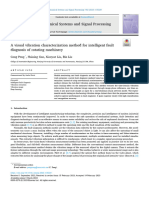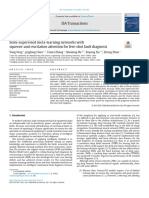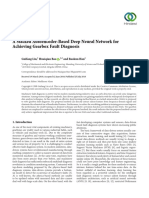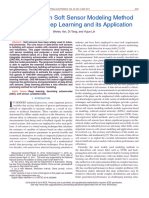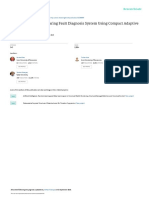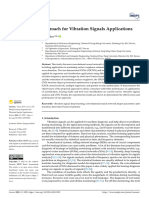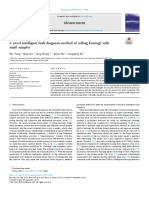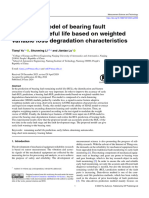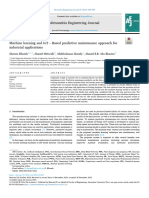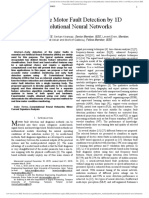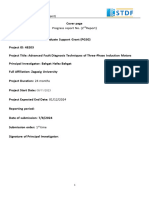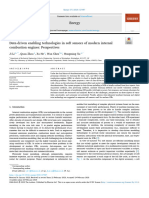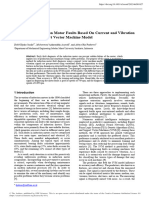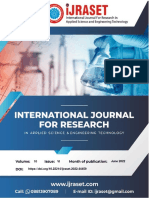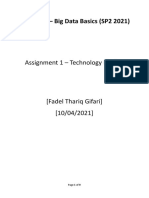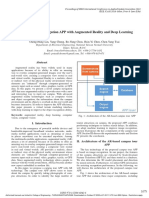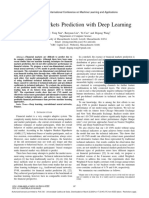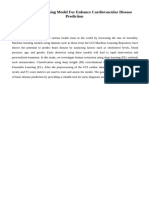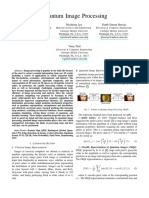14th ICCCNT 2023 Paper 942
14th ICCCNT 2023 Paper 942
Uploaded by
miniature testCopyright:
Available Formats
14th ICCCNT 2023 Paper 942
14th ICCCNT 2023 Paper 942
Uploaded by
miniature testOriginal Title
Copyright
Available Formats
Share this document
Did you find this document useful?
Is this content inappropriate?
Copyright:
Available Formats
14th ICCCNT 2023 Paper 942
14th ICCCNT 2023 Paper 942
Uploaded by
miniature testCopyright:
Available Formats
IEEE - 56998
An NFNet-Based Approach for Enhanced Bearing
Fault Classification Using Vibrational Signal
Analysis
Vidhi Jain Mayank Dixit Vihaan Misra
Department of Electrical Engineering Department of Electrical Engineering Department of Electrical Engineering
Netaji Subhas University of Netaji Subhas University of Netaji Subhas University of
Technology Technology Technology
Delhi, India Delhi, India Delhi, India
vidhi.ee19@nsut.ac.in mayank.ee19@nsut.ac.in vihaan.ee19@nsut.ac.in
Geetansh Bhutani Vijander Singh
Department of Electrical Engineering Department of Instrumentation and
Netaji Subhas University of Control Engineering
Technology Netaji Subhas University of
Delhi, India Technology
geetansh.ee19@nsut.ac.in Delhi, India
vijaydee@nsut.ac.in
Abstract— The present work proposes a novel approach for shown great promise in various image and signal processing
detecting bearing faults in induction motors using vibrational tasks. NFNet is a type of deep neural network architecture
signals. The proposed method employs a Normalizer-Free that addresses some of the limitations of previous
ResNet (NFNet) architecture to extract relevant features from normalization techniques, such as Batch Normalization (BN)
2D image representations of raw vibration data and a [7] and Group Normalization (GN) [8]. Normalization
classification model to identify the presence of a fault. We
convert the vibrational signals into 2D images by applying the
techniques have been used in neural networks to stabilize
Short-Time Fourier Transform (STFT) technique, which offers training and accelerate convergence, but they can also
a time-frequency analysis of the signals. The proposed method introduce certain issues, like computational overhead,
improves accuracy over conventional approaches along with reduced representational capacity and the need for careful
reduced computational overhead by using high-performance hyperparameter tuning [9]– [11].
NFNet architecture for classification. The effectiveness of the The methodology presented in this paper employs
proposed method is evaluated on the Case Western Reserve the NFNet architecture, which offers significant advantages
University (CWRU) and Intelligent Maintenance Systems (IMS) in the context of bearing fault classification. NFNet
datasets of vibration signals from induction motors, effectively eliminates the need for normalization layers by
experiencing various bearing faults. The results indicate that the
suggested framework outperforms the existing methods in terms
utilizing the Adaptive Gradient Clipping (AGC) technique,
of accuracy and efficiency, achieving state-of-the-art results. resulting in improved performance and a reduced demand for
This method can be used for real-time monitoring of induction computational resources compared to traditional techniques.
motors to detect bearing faults and prevent potential equipment The AGC allows for stable training and faster convergence
failures, making it highly useful for industrial applications. without sacrificing representational capacity, making the
method more robust in the face of diverse operating
Keywords—Signal Processing, Bearing Faults, Computer conditions and bearing fault scenarios. Additionally, we
Vision convert vibrational signals into 2D images using the STFT
providing a time-frequency analysis of the data. This
I. INTRODUCTION
transformation allows the subsequent use of the powerful
Induction motors are widely used in various NFNet-based image classification model, which has
industrial applications such as pumps, fans, compressors, and demonstrated state-ofthe-art performance on various image
conveyors. Detecting bearing faults in these motors is crucial recognition benchmarks. The NFNet-based classifier is then
to prevent potential equipment failures, which can lead to employed to detect the presence of a fault, outperforming
costly downtime and maintenance [1], [2]. Vibration analysis previous models and offering improved accuracy in bearing
is a widely used technique for detecting bearing faults in fault classification.
induction motors. However, existing methods involve use of To assess the efficacy of the proposed method, we
techniques such as the Envelope Analysis [3], the Wavelet conducted evaluations on four publicly accessible datasets:
Transform [4], and the Short-time Fourier Transform (STFT) the Case Western Reserve University (CWRU) Dataset [12],
[5], have proven to be limited in terms of accuracy and the Paderborn University Dataset [13], the Intelligent
efficiency. Maintenance Systems (IMS) Dataset [14], and the Condition
These methods are either sensitive to the choice of Based Maintenance Fault Database for Testing of Diagnostic
parameters or require a high computational cost. Recently, and Prognostics Algorithms (MFPT) Dataset [15]. Each
the Normalizer-Free ResNet (NFNet) architecture [6] has dataset encompasses a variety of operating conditions and
14th ICCCNT IEEE Conference
July 6-8, 2023
IIT- Delhi, Delhi, India
IEEE - 56998
Figure 1: Our proposed framework
bearing faults. Our findings reveal that the proposed method outperformed conventional machine learning methods.
surpasses existing techniques in terms of both accuracy and Researchers employed Convolutional Neural Networks
efficiency, thereby achieving state-of-the-art results. (CNN) to detect bearing faults, which exclusively accept
vibration signals as input data [21]. Traditional ML methods
This work introduces a versatile framework (Fig. 1) predominantly consist of shallow models, rendering the
that delivers high performance in terms of accuracy and
computational efficiency. This method is suitable for real-
time monitoring of induction motors to detect bearing faults extraction of non-linear and non-stationary features from
and prevent potential equipment failures, making it valuable vibration signals a challenge [22]. In one particular
for industrial applications. Additionally, it allows easy investigation, researchers implemented a 1D CNN as direct
integration with existing monitoring systems, providing a input for raw temporal signals to accomplish end-to-end
comprehensive solution for real-time supervision of bearing defect identification, achieving impressive diagnostic
induction motors. The suggested approach can be extended to accuracy inspite of noise and varying operational loads [23].
other types of rotating machinery by using appropriate Numerous studies have introduced multiscale CNNs for
datasets and fine-tuning the pre-trained model accordingly. detecting wind turbine gearbox defects, achieving
exceptional accuracy by fusing multiscale learning with deep
The key contributions of this research work are learning techniques. This process involved transforming
summarized as follows: signals into two-dimensional (2D) images [24]. Till date, DL
• Proposing a widely applicable and efficient bearing fault models with CNN-like architectures have predominantly
detection method for induction motors based on vibrational governed computer vision tasks, establishing themselves as
signals, using the Normalizer-Free ResNet (NFNet) the industry benchmark for image classification and object
architecture. recognition [25]– [27]. CNNs apply convolutional filters on
• Exploiting the benefits of Adaptive Gradient Clipping images to extract crucial features for discerning objects of
(AGC) in NFNet to enable stable training and faster interest in images. Convolutional operations accomplish this
convergence without the need for normalization layers, by capturing essential properties such as local connection,
leading to improved performance and reduced computational parameter (weight) sharing, and translation equivariance
resources. [28], [29]. Regrettably, CNNs exhibit suboptimal
• Employing the STFT technique for converting vibrational performance in learning long-range information, which
signals into 2D images, providing a time-frequency analysis constrains their proficiency in visual tasks, primarily due to
that facilitates the use of powerful NFNet-based image their localized receptive fields [30].
classification model. In these previous studies on bearing fault detection
• Providing a thorough performance analysis of the proposed in induction motors, traditional techniques such as Envelope
method, comparing it to traditional and current state-of-the- Analysis, Wavelet Transform, and the Short-time Fourier
art approaches on the given datasets. Transform (STFT) have demonstrated limitations in terms of
accuracy and computational efficiency. These methods are
II. RELATED WORKS sensitive to parameter choices and require substantial
Extensive research has been conducted on bearing computational resources. Although normalization techniques
health monitoring, employing data-driven methodologies like Batch Normalization (BN) and Group Normalization
such as machine learning (ML) and deep learning (DL) to (GN) have been utilized to stabilize training in neural
anticipate and detect bearing defects. Compromised bearings networks, they introduce complexities such as computational
may jeopardize the functionality of an entire machine or overhead and reduced representational capacity. Therefore, a
system [16]– [18]. In one investigation, time-domain signal novel approach is needed to overcome these limitations and
features were extracted for classification, and an artificial advance the state-of-the-art in bearing fault classification.
neural network (ANN) was employed to discern induction Our proposed methodology offers several key
motor bearing anomalies [19]. contributions. Firstly, it eliminates the reliance on
Another study utilized frequency-domain attributes normalization layers, reducing computational overhead and
as input data for Support Vector Machine (SVM) to identify improving efficiency for real-time applications. Secondly,
machine defects [20]. The deep learning technique has the incorporation of the STFT-based image representation
14th ICCCNT IEEE Conference
July 6-8, 2023
IIT- Delhi, Delhi, India
IEEE - 56998
enables a comprehensive time-frequency analysis, resulting and remove noise components. In this work, STFT (Fig. 3) is
in a more informative and discriminative feature set for used to denoise the raw data and convert into 2D time-frequency
bearing fault classification. Lastly, our methodology images. In this method, the non-stationary vibration signal is
demonstrates superior performance in terms of accuracy, multiplied by the time series using a window function until it
robustness, and computational resource requirements almost becomes locally stationary, at which it is converted to the
compared to existing techniques. By overcoming previous time-frequency domain. The time-frequency domain average of
limitations and introducing innovative elements, our research STFT spectrograms improves the indications of localized fault.
opens new avenues for enhanced bearing fault detection in The phase highlights the energy flow related to interactions
induction motors. This contributes to the prevention of between the bearing’s faulty parts and improves the signal-to-
equipment failures, cost reduction, and improved noise ratio.
maintenance practices in industrial applications.
III. METHODOLOGY
The three pillars of the fault detection process in
vibration analysis are data collecting, signal processing, and
fault classification, as shown in Fig. 2. Data collection
methods include the use of sensors and analyzers.
Accelerometers, displacement transducers, velocity
transducers, and other sensors are frequently employed to
gather vibration data. The signal processing unit receives the
collected data and continues to process the signals. The
statistics include all necessary details regarding the state of Figure 3: Short-time Fourier Transform
the bearings. Short-Time Fourier Analysis is used to convert
the raw vibrational data from sensors into 2D time-frequency B. NFNet
images. STFT is a time-frequency analysis technique that For the purpose of bearing fault detection using
provides a representation of signals and images in both the vibration signals, the NFNet architecture is used as a
time and frequency domains. The performance with respect backbone for the classification model. The input to the
to Signal denoising, signal filtering, signal amplification, and model is a vector of 256 features extracted from the Fourier
feature extraction are compared for STFT and FBSP in this transform of a vibration signal segment. The architecture of
work. Then State-of-the-art NFNet is used for the final NFNet model used for bearing fault detection consisted of
classification of 2D time-frequency images to detect the 26 convolutional layers, each followed by an adaptive
bearing fault. gradient clipping operation. The adaptive gradient clipping
operation clipped the gradients based on their norm, which
is computed on the fly during training. This helps to improve
the stability of the training process and reduce the impact of
large gradients that leads to oscillations or divergence
during training. The convolutional layers used in the NFNet
model for bearing fault detection employed a range of kernel
sizes, including 3x3, 5x5, and 7x7, with varying numbers of
output channels. The kernel sizes and output channel counts
were chosen based on empirical experimentation to achieve
optimal performance on the bearing fault detection task. The
NFNet architecture also included several other techniques to
improve performance, including weight standardization,
which normalized the weights of each convolutional layer
Figure 2. Overview of the data acquisition, preprocessing and to have zero mean and unit variance, and weight decay,
classification process proposed. which added a penalty term to the loss function based on the
magnitude of the weights.
A. Short-time Fourier Transform The NFNet model for bearing fault detection ended with
By employing vibration monitoring to find machine faults, a global average pooling layer, which reduced the spatial
every dynamic machine component can be seen in the machine’s dimensions of the feature maps to a single value for each
measured vibration response at its characteristic frequencies. To feature map, while preserving the channel information. The
gather important information about the machine’s health, the global average pooling layer was followed by a fully
machine’s vibration must first be captured, and then the connected layer for classification, which mapped the
vibration signal must be processed. Vibrations are observed near features to the output classes. During training, the NFNet
the bearings that support the rotating frequency scales in the model was optimized using the Adam optimizer with a
time-frequency domain. A vibration signal is made up of learning rate of 0.001 and a batch size of 128. The model
numerous signal constituents with various properties, including was trained for 100 epochs, with early stopping based on the
linear and non-linear behavior, stationary and non-stationary, validation loss. The performance of the model was
etc. Therefore, it is important to do a time-frequency analysis in evaluated using standard classification metrics, including
order to efficiently extract the fault characteristic characteristics training accuracy, validation accuracy, Jaccard score, G-
14th ICCCNT IEEE Conference
July 6-8, 2023
IIT- Delhi, Delhi, India
IEEE - 56998
TABLE 1: PERFORMANCE EVALUATION OF PROPOSED ARCHITECTURE AGAINST STATE-OF-THE-ART MODELS
ON CWRU DATASET
NFNet (Ours) ResNet AlexNet MobileNet
Accuracy (in %) 98.87±0.23 98.25±0.34 97.76±0.27 97.11 ±0.47
Validation Accuracy (in %) 98.72±0.35 98.36±0.67 97.63±0.61 96.84±0.63
Average Training Time (in seconds) 201.74 290.33 213.56 227.54
Loss 0.0407 0.0713 0.0782 0.0821
Jaccard Score 0.9685 0.9318 0.9159 0.9003
G-Measure 0.9835 0.9801 0.9784 0.9779
F1-Score 0.9835 0.9799 0.9782 0.9776
Wins out of 20 runs (higher validation accuracy) 17 2 1 0
measure and F1-score. Overall, the NFNet architecture was speed of 2000 rpm, with all failures occurring after
chosen for bearing fault detection due to its ability to handle surpassing the bearing’s designed lifetime of over 100
large amounts of data and its advanced techniques for million revolutions. The shaft and bearings experienced a
improving stability and generalization performance. radial load of 6000 lbs., applied by a spring mechanism
while the bearings were lubricated. The test endured for
IV. EXPERIMENTAL SETUP
35 days until a significant volume of metal debris was
The following experiments are conducted to discovered on
evaluate the impact of our framework on the CWRU and IMS the magnetic plug of the examined bearing, prompting the
datasets. The performance of NFNet model used in the inspection of the bearing’s individual components.
present work are compared with other models of ResNet to
further evaluate the performance of the proposed approach.
The comparison helped us to understand the advantages of
Across three tests, a total of 12 bearings were utilized, with
using an NFNet-based architecture over existing frameworks.
each test employing four bearings. However, only four
Any identical data points in the entire dataset are dropped to
bearings with identified defects were deemed to have failed.
ensure that the training and test sets are independent and
validation metrics are not affected. Datasets: Two datasets of Each file within the dataset encompasses 20,480 data points,
vibrations are captured induced by the different sensors and collected at a sampling rate of 20 kHz.
in different load conditions.
Experimental Setting: The system uses a single NVIDIA
1) CWRU [12]: For the classification of bearing faults, GeForce GTX 1660Ti graphics processing unit (GPU),
vibration signals are acquired utilizing accelerometers on Intel(R) i7 central processing unit (CPU), and 16 GB RAM.
We also outline the specific hyperparameters and settings for
experimental data sourced from the Case Western Reserve
the NFNet model utilized for fault classification in our
University (CWRU) bearing failure laboratory. The CWRU
research.
testing apparatus comprises a motor, dynamometer, torque
1) Model depth: We used an NFNet model with a depth
sensor, and electronic control equipment. The dataset of L = 50 layers, where each layer consists of a
encompasses four distinct categories of data: baseline normal combination of convolutional, activation, and pooling
data, drive end fault data, and fan end fault data. Four operations.
disparate motor loads and speeds (1797, 1772, 1750, and 2) Growth rate: The growth rate k was set to 32,
1730 r/min) are employed, in conjunction with a sampling determining the increase in the number of feature maps
frequency of 12 kHz, to gather the vibration signals. Inner per layer in the model which influences the network’s
race fault, outer race fault, ball fault, and normal fault types capacity and computational requirements.
make up the majority of the dataset. For each load (0, 1, 2, 3) Learning rate: The initial learning rate η was set to 1
and 3 hp), the fault diameters are 0.007 inches, 0.014 inches, × 10−3 , and it was updated using a cosine annealing
and 0.021 inches, respectively. After obtaining the 40 raw schedule with a linear warm-up phase of 5 epochs.
samples under 10 unique health conditions and 4 diverse 4) Weight decay: A weight decay coefficient λ of 1×10−4
working conditions, they are segmented into 150 samples, was used to regularize the model weights during training
each containing 800 sampling points. In total, 6,000 samples and prevent overfitting.
are collected, with 150 samples allocated for each operational 5) Batch size: We employed a batch size of B = 128
scenario and 600 samples designated for each health during training, balancing computational efficiency and
condition. memory constraints.
6) Adaptive Gradient Clipping (AGC): The AGC clipping
2) IMS [14]: The dataset here contains run-to-failure factor α was set to a value of 2×10−3, controlling the
vibration data originating from bearings. Each bearing scaling of gradients during the optimization process.
features 16 rollers per row, with a pitch diameter of 2.815 7) Training epochs: The NFNet model was trained for a
inches and a roller diameter of 0.331 inches. High sensitivity total of T = 100 epochs, ensuring convergence and
optimal performance on the given datasets. The chosen
accelerometers are mounted on the bearing housing, and the
hyperparameters were determined through an extensive
bearings possess a tapered contact angle of 15.17 degrees.
process of experimentation and validation, considering
Four bearings were installed on a shaft rotating at a consistent
14th ICCCNT IEEE Conference
July 6-8, 2023
IIT- Delhi, Delhi, India
IEEE - 56998
multiple combinations and setups. The final configuration TABLE 2: PERFORMANCE EVALUATION OF PROPOSED ARCHITECTURE
AGAINST STATE-OF-THE-ART MODELS
provided promising results, achieving both high
classification accuracy and computational efficiency in CWRU IMS
the fault classification task. Zime et al. [31] 98.00% x
Ali et al. [32] x 93.0%
Metrics: We evaluate our proposed methods using the Luo et al. [33] x 93.0%
standard widely used metrics for classification: Accuracy
Proposed Algorithm 98.72% 95.7%
(train and validation), Loss, Jaccard Score, and G-Measure.
Evaluation: 5-fold cross-validation is adopted on the data. These findings have far-reaching implications for the
We split the dataset into a training and validation set (80-20). industrial sector, where the ability to monitor induction
These sets are selected such that their class distribution is motors in real-time and avert potential equipment failures is
representative of the original dataset (stratified k-fold). of critical importance. Our approach can be readily adapted
to other types of rotating machinery, enabling the creation of
The training set is split into five folds (one is used as a test extensive and robust condition monitoring systems.
set), with the validation set being kept separate. This
technique was followed to ensure that the models are not
biased and the results are generalizable. Each fold was VI. LIMITATIONS
scrutinized carefully to ensure that there was no data leakage While our proposed methodology advances bearing
from the train set to the validation set on all the runs. The fault detection for induction motors, certain limitations
experiments are run 20 times to test statistical robustness for should be considered for future research.
20 hypotheses testing. The proposed framework Firstly, the effectiveness of the NFNet architecture
outperformed SOTA baselines in 17 out of 20 runs. The and AGC technique relies on ample labeled training data.
statistical average of all metrics obtained over 20 runs are Acquiring and annotating such data is resource-intensive,
considered to report the concluding value with the mean of particularly for rare fault scenarios. Expanding diverse
each metric. All models are evaluated on the same data set for labeled datasets will validate and generalize our
validation. The standard deviations are also reported for methodology.
training and validation accuracy.
Secondly, converting vibrational signals into 2D
images using the STFT entails a trade-off between time and
V. RESULTS AND DISCUSSION frequency resolution. Optimizing STFT parameters remains
In this section, we discuss the various experiments a challenge, requiring specific adjustments for fault types and
conducted using different strategies and compare them with operating conditions. Automated or adaptive parameter
the results obtained using our architecture. All the metrics selection methods should be explored.
reported are the average values over 20 runs. Dependency on the NFNet architecture introduces
In order to showcase the superiority of employing a limitations in extremely resource-constrained environments.
knowledge-transfer-based network over conventional scratch While AGC reduces computational demands, hardware or
training, we present a comprehensive summary of our real-time constraints may limit our methodology's
findings across all datasets, coupled with a comparison of applicability. Optimization strategies could balance
training time. Table 1 provides clear evidence of the computational requirements and NFNet's superior
favorable outcomes achieved in terms of crucial performance performance.
metrics such as accuracy, validation accuracy, Jaccard score, Lastly, our methodology focuses on bearing fault
G1-measure, and loss, along with a significant reduction in detection in induction motors, excluding other potential
training time, calculated as an average across 20 iterations. faults. Extending our approach to address stator winding
Moreover, we also observe that the standard deviation of the faults or rotor bar defects would offer a more comprehensive
accuracy of transfer learning architecture is lesser than the motor condition monitoring solution.
standard deviation observed for the accuracy values in By recognizing these limitations, future research can
training from scratch. In addition to comparing with overcome challenges, advancing bearing fault detection and
conventional techniques, we assessed our method against enhancing industrial operations' reliability and efficiency.
various baseline models. Our analysis demonstrated that our
approach substantially outperformed the alternative models VII. CONCLUSION
on both datasets, showcasing the advantages of our method The present work introduces a highly effective
in terms of computational efficiency and precision. framework for pinpointing bearing faults in induction motors
Finally, to evaluate the optimal performance of our by harnessing the power of the NFNet architecture and
proposed architecture against the state-of-the-art models, we vibrational signal analysis. The design of the method
present a comprehensive comparative assessment in Table 2. optimizes computational efficiency and bolsters the
This analysis considers the reported metrics and their robustness of the approach. Moreover, the utilization of the
corresponding datasets, showcasing the resource STFT technique to transform vibrational signals into 2D
optimization of our approach. Our comprehensive evaluation, images offers a notable improvement over existing models,
which includes a comparison with conventional techniques enhancing both the accuracy and efficiency of the method.
and the latest research on two publicly available datasets, This work offers a contribution to the field of
highlights the superior performance of our approach. machine learning and signal processing techniques for
14th ICCCNT IEEE Conference
July 6-8, 2023
IIT- Delhi, Delhi, India
IEEE - 56998
predictive maintenance and condition monitoring in [24] R. Liu, G. Meng, B. Yang, C. Sun, and X. Chen, “Dislocated time
seriesconvolutional neural architecture: An intelligent fault diagnosis
industrial applications. By presenting a versatile and efficient
approach for electric machine,” IEEE Transactions on Industrial
for bearing fault detection in induction motors, proposed Informatics,vol. 13, no. 3, pp. 1310–1320, 2017.
approach exemplifies the potential of combining deep [25] Y. Lecun, Generalization and network design strategies. Elsevier,
learning models and signal processing techniques to elevate 1989.
the performance of fault detection systems in terms of both [26] A. Krizhevsky, I. Sutskever, and G. E. Hinton, “Imagenet
classification with deep convolutional neural networks,” in Advances
accuracy and efficiency. in Neural Information Processing Systems, F. Pereira, C. Burges, L.
Bottou, and K. Weinberger, Eds., vol. 25. Curran Associates, Inc.,2012.
[Online].
REFERENCES [27] K. He, X. Zhang, S. Ren, and J. Sun, “Deep residual learning for image
recognition,” 2015. [Online].
[1] V. Barai, S. M. Ramteke, V. Dhanalkotwar, Y. Nagmote, S. Shende,
[28] Y. LeCun, B. Boser, J. Denker, D. Henderson, R. Howard, W.
and D. Deshmukh, “Bearing fault diagnosis using signal processing
Hubbard, and L. Jackel, “Handwritten digit recognition with a back-
and machine learning techniques: A review,” IOP Conference Series:
propagation network,” in Advances in Neural Information Processing
Materials Science and Engineering, vol. 1259, no. 1, p. 012034, oct
Systems, D. Touretzky, Ed., vol. 2. Morgan-Kaufmann, 1989. [Online].
2022. [Online].
[29] Y. LeCun, Y. Bengio, and G. Hinton, “Deep learning,” Nature, vol.
[2] D.-T. Hoang and H.-J. Kang, “A survey on deep learning based bearing
521, no. 7553, pp. 436–444, May 2015. [Online]. Available:
fault diagnosis,” Neurocomput., vol. 335, no. C, p. 327–335, mar 2019.
https://doi.org/10.1038/nature14539
[Online].
[30] A. Hatamizadeh, Y. Tang, V. Nath, D. Yang, A. Myronenko,B.
[3] E. Bechhoefer, “A quick introduction to bearing envelope analysis,”
Landman, H. Roth, and D. Xu, “Unetr: Transformers for 3d medical
Green Power Monitoring Systems: Cornwall, VT, USA, 2016.
image segmentation,” 2021. [Online].
[4] S. Prabhakar, A. R. Mohanty, and A. Sekhar, “Application of discrete
[31] Zim, A. H., Ashraf, A., Iqbal, A., Malik, A. & Kuribayashi, M. A
wavelet transform for detection of ball bearing race faults,” Tribology
vision transformer-based approach to bearing fault classification via
International, vol. 35, no. 12, pp. 793–800, 2002.
vibration signals (2022).
[5] H. Gao, L. Liang, X. Chen, and G. Xu, “Feature extraction and
[32] Ben Ali, J., Fnaiech, N., Saidi, L., Chebel- Morello, B. & Fnaiech, F.
recognition for rolling element bearing fault utilizing short-time fourier
Application of empirical mode decomposition and artificial neural
transform and non-negative matrix factorization,” Chinese Journal of
network for automatic bearing fault diagnosis based on vibration
Mechanical Engineering, vol. 28, no. 1, pp. 96–105, 2015.
signals. Applied Acoustics 89, 16–27 (2015).
[6] A. Brock, S. De, S. L. Smith, and K. Simonyan, “High-performance
[33] Luo, P. & Hu, Y. Research on rolling bearing fault identification
large-scale image recognition without normalization,” CoRR, vol.
method based on lstm neural network. IOP Conference Series:
abs/2102.06171, 2021. [Online].
Materials Science and Engineering 542, 012048 (
[7] S. Ioffe and C. Szegedy, “Batch normalization: Accelerating deep
network training by reducing internal covariate shift,” 2015.
[8] Y. Wu and K. He, “Group normalization,” 2018.
[9] S. R. Bulo, L. Porzi, and P. Kontschieder, “In-place activated batchnorm
` for memory-optimized training of dnns,” CoRR, vol. abs/1712.02616,
2017. [Online].
[10] C. Summers and M. J. Dinneen, “Four things everyone should know
to improve batch normalization,” 2020.
[11] S. Singh and A. Shrivastava, “Evalnorm: Estimating batch
normalization statistics for evaluation,” 2019.
[12] O. Case Western Reserve University, Cleveland, “Bearing data center
seeded fault test data,”
[13] Padderborn University, “Bearing data center,”
[14] G. Y. J. L. J. Lee, H. Qiu and R. T. S. (2007), “Center for intelligent
maintenance systems (ims) dataset,”
[15] E. Bechhoefer, “Condition based maintenance fault database for
testing of diagnostic and prognostics algorithms,”.
[16] P. Kankar, S. C. Sharma, and S. Harsha, “Fault diagnosis of ball
bearings using machine learning methods,” Expert Systems with
Applications, vol. 38, no. 3, pp. 1876–1886, 2011. [Online].
[17] D.-T. Hoang and H.-J. Kang, “A survey on deep learning based bearing
fault diagnosis,” Neurocomputing, vol. 335, pp. 327–335, 2019.
[Online].
[18] G. Bin, J. Gao, X. Li, and B. Dhillon, “Early fault diagnosis of rotating
machinery based on wavelet packets—empirical mode decomposition
feature extraction and neural network,” Mechanical Systems and
Signal Processing, vol. 27, pp. 696–711, 2012. [Online].
[19] D. Zhao, Z. Lin, and Y. Wang, “Integrated state/disturbance observers
for two-dimensional linear systems,” IET Control Theory &
Applications, vol. 9, no. 9, pp. 1373–1383, 2015. [Online].
[20] R. K. Patel, S. Agrawal, and V. K. Giri, “Induction motor bearing fault
classification using pca and ann,” in Computing Algorithms with
Applications in Engineering, V. K. Giri, N. K. Verma, R. K. Patel, and
V. P. Singh, Eds. Singapore: Springer Singapore, 2020, pp. 269–284.
[21] Z. Chen, A. Mauricio, W. Li, and K. Gryllias, “A deep learning method
for bearing fault diagnosis based on cyclic spectral coherence and
convolutional neural networks,” Mechanical Systems and Signal
Processing, vol. 140, p. 106683, 2020. [Online].
[22] A. Widodo and B.-S. Yang, “Support vector machine in machine
condition monitoring and fault diagnosis,” Mechanical Systems and
Signal Processing, vol. 21, no. 6, pp. 2560–2574, 2007. [Online].
[23] D.-T. Hoang and H.-J. Kang, “Rolling element bearing fault diagnosis
using convolutional neural network and vibration image,” Cognitive
Systems Research, vol. 53, pp. 42–50, 2019, advanced Intelligent
Computing. [Online].
14th ICCCNT IEEE Conference
July 6-8, 2023
IIT- Delhi, Delhi, India
IEEE - 56998
14th ICCCNT IEEE Conference
July 6-8, 2023
IIT- Delhi, Delhi, India
You might also like
- PMP Pre Exam PosterDocument1 pagePMP Pre Exam Posterminiature test100% (1)
- Introduction To HTML5 Quiz AnswersDocument5 pagesIntroduction To HTML5 Quiz Answersminiature test100% (1)
- A Visual Vibration Characterization Method For Int - 2023 - Mechanical Systems ADocument11 pagesA Visual Vibration Characterization Method For Int - 2023 - Mechanical Systems Ageanina grosanNo ratings yet
- Bearing Fault Diagnosis in Induction Motor Using Continuous Wavelet Transform and Convolutional Neural NetworksDocument12 pagesBearing Fault Diagnosis in Induction Motor Using Continuous Wavelet Transform and Convolutional Neural NetworksInternational Journal of Power Electronics and Drive SystemsNo ratings yet
- Novel Convolutional Neural Network (NCNN) For The Diagnosis of Bearing Defects in Rotary MachineryDocument10 pagesNovel Convolutional Neural Network (NCNN) For The Diagnosis of Bearing Defects in Rotary MachineryBhargav TcNo ratings yet
- IEECP - Article - 241 (Alasmer Ibrahim Et Al.)Document6 pagesIEECP - Article - 241 (Alasmer Ibrahim Et Al.)BharathNo ratings yet
- Electronics: An Improved Fault Diagnosis Using 1D-Convolutional Neural Network ModelDocument19 pagesElectronics: An Improved Fault Diagnosis Using 1D-Convolutional Neural Network ModelSerosh KarimNo ratings yet
- PDM For Conveyor BeltsDocument17 pagesPDM For Conveyor BeltsOwais JafriNo ratings yet
- 1 s2.0 S0019057821001543 MainDocument19 pages1 s2.0 S0019057821001543 Main1No ratings yet
- Ali SaadDocument6 pagesAli SaadEri SukocoNo ratings yet
- HindawiDocument11 pagesHindawiUma MaheshwarNo ratings yet
- A Data-Driven Soft Sensor Modeling Method Based On Deep Learning and Its ApplicationDocument9 pagesA Data-Driven Soft Sensor Modeling Method Based On Deep Learning and Its ApplicationRAFAEL VASCONCELOS COSTA MACHADONo ratings yet
- Using Artificial Intelligence (AI) For Monitoring and Diagnosing Electric Motor Faults Based On Vibration SignalsDocument6 pagesUsing Artificial Intelligence (AI) For Monitoring and Diagnosing Electric Motor Faults Based On Vibration SignalsÀlex QuintanaNo ratings yet
- Eren Et Al-2018-Journal of Signal Processing SystemsDocument12 pagesEren Et Al-2018-Journal of Signal Processing SystemsIvana MilašNo ratings yet
- 1 s2.0 S0263224121002402 MainDocument19 pages1 s2.0 S0263224121002402 Mainvikas sharmaNo ratings yet
- Deep LearningDocument18 pagesDeep LearningSripriyan K 100507No ratings yet
- Digital TwinsDocument10 pagesDigital TwinsLê Anh ĐứcNo ratings yet
- ISA Transactions: Tongyang Pan, Jinglong Chen, Jinsong Xie, Yuanhong Chang, Zitong ZhouDocument11 pagesISA Transactions: Tongyang Pan, Jinglong Chen, Jinsong Xie, Yuanhong Chang, Zitong Zhourahulbhattt918No ratings yet
- Sensors: Bearing Fault Diagnosis Method Based On Deep Convolutional Neural Network and Random Forest Ensemble LearningDocument21 pagesSensors: Bearing Fault Diagnosis Method Based On Deep Convolutional Neural Network and Random Forest Ensemble LearningFelipe Andres Figueroa VidelaNo ratings yet
- Convolutional - Autoencoder - and - Transfer - Learning - For - Automatic - Virtual - Metrology (IEEE RA-L, July 2022)Document8 pagesConvolutional - Autoencoder - and - Transfer - Learning - For - Automatic - Virtual - Metrology (IEEE RA-L, July 2022)mice LiNo ratings yet
- Vision Based Feature Diagnosis For Automobile Instrument Cluster Using Machine LearningDocument6 pagesVision Based Feature Diagnosis For Automobile Instrument Cluster Using Machine Learningاحمد نديم اسماعيلNo ratings yet
- Implementation of Deep Neural Networks Learning On Unmanned Aerial Vehicle Based Remote-SensingDocument7 pagesImplementation of Deep Neural Networks Learning On Unmanned Aerial Vehicle Based Remote-SensingIAES IJAINo ratings yet
- Analysis of Permanent Magnet Synchronous MotorDocument15 pagesAnalysis of Permanent Magnet Synchronous Motormalini72No ratings yet
- SF2023Document7 pagesSF2023Phước Bùi TháiNo ratings yet
- Improving Semiconductor Device Modeling For ElectrDocument9 pagesImproving Semiconductor Device Modeling For Electrt01050164281No ratings yet
- Conv-MCD: A Plug-and-Play Multi-Task Module For Medical Image SegmentationDocument8 pagesConv-MCD: A Plug-and-Play Multi-Task Module For Medical Image SegmentationGaston GBNo ratings yet
- 1 s2.0 S0278612524001584 MainDocument25 pages1 s2.0 S0278612524001584 Mainnarendrabalu1989No ratings yet
- IET Wireless Sensor Systems - 2022 - Hayouni - Wireless IoT Universal Approach Based On Allan Variance Method For DetectionDocument12 pagesIET Wireless Sensor Systems - 2022 - Hayouni - Wireless IoT Universal Approach Based On Allan Variance Method For Detectionalvaro jose diaz ramirezNo ratings yet
- Vibration Signal Diagnosis and Analysis of Rotating Machine by Utilizing Cloud ComputingDocument10 pagesVibration Signal Diagnosis and Analysis of Rotating Machine by Utilizing Cloud ComputingDrRajeev ChauhanNo ratings yet
- 2022 - YANG - A Novel Intelligent Fault Diagnosis Method of Rolling Bearings...Document11 pages2022 - YANG - A Novel Intelligent Fault Diagnosis Method of Rolling Bearings...igorbassoNo ratings yet
- Prediction Model of Bearing Fault Remaining UsefulDocument19 pagesPrediction Model of Bearing Fault Remaining Usefuldoctorante90eltNo ratings yet
- A Sequence - To - Sequence Approach For Remaining Useful Lifetime Estimation Using Attention Augmented Bidirectional LSTMDocument18 pagesA Sequence - To - Sequence Approach For Remaining Useful Lifetime Estimation Using Attention Augmented Bidirectional LSTMowais khanNo ratings yet
- Machine Learning and IoT – Based Predictive Maintenance Approach for Industrial ApplicationsDocument12 pagesMachine Learning and IoT – Based Predictive Maintenance Approach for Industrial Applicationsgregoriopilnio60No ratings yet
- CNN For AVM (IEEE RA-L, July 2021)Document8 pagesCNN For AVM (IEEE RA-L, July 2021)mice LiNo ratings yet
- WellDamage MLDocument2 pagesWellDamage MLTamires SoaresNo ratings yet
- Real-Time Motor Fault Detection by 1D Convolutional Neural NetworksDocument10 pagesReal-Time Motor Fault Detection by 1D Convolutional Neural NetworksJaimeNo ratings yet
- Chatterjee2021 - Scientometric Review of Artificial Intelligence For OperationsDocument31 pagesChatterjee2021 - Scientometric Review of Artificial Intelligence For Operations蔡杰No ratings yet
- An Efficient Face Detector On A CPU Using Dual-Camera Sensors For Intelligent SuDocument10 pagesAn Efficient Face Detector On A CPU Using Dual-Camera Sensors For Intelligent SumanibalaNo ratings yet
- Iee Paper IotDocument3 pagesIee Paper Iotpp ccNo ratings yet
- RftyDocument15 pagesRftyBahgat HafezNo ratings yet
- Weight-Oriented Approximation for Energy-Efficient Neural Network Inference AcceleratorsDocument14 pagesWeight-Oriented Approximation for Energy-Efficient Neural Network Inference AcceleratorsjspkayNo ratings yet
- ji liDocument9 pagesji liarunambrose2004No ratings yet
- Ele 02 NcrenbDocument5 pagesEle 02 NcrenbAdwait Harishchandra MalasheNo ratings yet
- Alarm Classification Prediction Based On Cross-Layer Artificial Intelligence Interaction in Self-Optimized Optical Networks (SOON)Document8 pagesAlarm Classification Prediction Based On Cross-Layer Artificial Intelligence Interaction in Self-Optimized Optical Networks (SOON)jluis98No ratings yet
- Sensors: Naive Bayes Bearing Fault Diagnosis Based On Enhanced Independence of DataDocument17 pagesSensors: Naive Bayes Bearing Fault Diagnosis Based On Enhanced Independence of DataSérgio CustódioNo ratings yet
- A - Deep - Learning - Model - For - Smart - Manufacturing - Using - Convolutional - LSTM - Neural - Network - Autoencoders OkDocument10 pagesA - Deep - Learning - Model - For - Smart - Manufacturing - Using - Convolutional - LSTM - Neural - Network - Autoencoders OkFerry amirulNo ratings yet
- Discrete Time ModelDocument10 pagesDiscrete Time ModelmuzammalNo ratings yet
- Sensors: A Convolutional Neural Network For Impact Detection and Characterization of Complex Composite StructuresDocument25 pagesSensors: A Convolutional Neural Network For Impact Detection and Characterization of Complex Composite Structuresathar shahzadNo ratings yet
- Predictive Maintenance in Manufacturing With AI and Data ScienceDocument3 pagesPredictive Maintenance in Manufacturing With AI and Data ScienceSMARTX BRAINSNo ratings yet
- Efficient Data Reduction at The Edge of Industrial Internet of Things For PMSM Bearing Fault DiagnosisDocument11 pagesEfficient Data Reduction at The Edge of Industrial Internet of Things For PMSM Bearing Fault DiagnosisbabourimohamedkhemissiNo ratings yet
- IJRPR26093Document6 pagesIJRPR26093gfyuu172No ratings yet
- 1 s2.0 S0888327021009675 MainDocument21 pages1 s2.0 S0888327021009675 Mainvincenzo.gattulliNo ratings yet
- Elk 2111 123Document17 pagesElk 2111 123SAHBI MARROUCHINo ratings yet
- Paper NewDocument6 pagesPaper Newriteshkumaryadav891No ratings yet
- Wang Et Al - 2020 - Multi-Scale Deep Intra-Class Transfer Learning For Bearing Fault DiagnosisDocument15 pagesWang Et Al - 2020 - Multi-Scale Deep Intra-Class Transfer Learning For Bearing Fault Diagnosiswenk.sitterding.opcNo ratings yet
- Ijecet: International Journal of Electronics and Communication Engineering & Technology (Ijecet)Document7 pagesIjecet: International Journal of Electronics and Communication Engineering & Technology (Ijecet)IAEME PublicationNo ratings yet
- Edgenext Efficiently Amalgamated Cnn-Transformer Architecture For Mobile Vision ApplicationsDocument10 pagesEdgenext Efficiently Amalgamated Cnn-Transformer Architecture For Mobile Vision Applications王大哥No ratings yet
- A Convolutional Neural Network For Impact Detection and Characterization of Complex Composite StructureDocument25 pagesA Convolutional Neural Network For Impact Detection and Characterization of Complex Composite StructureOtras CosasNo ratings yet
- Sensors 21 00891 v2Document17 pagesSensors 21 00891 v2nixmeupdrfjaexhvgaNo ratings yet
- Diagnosis of Induction Motor Faults Based On CurreDocument9 pagesDiagnosis of Induction Motor Faults Based On Curredoctorante90eltNo ratings yet
- Towards Reconfigurable CNN Accelerator For FPGA ImplementationDocument5 pagesTowards Reconfigurable CNN Accelerator For FPGA ImplementationpalansamyNo ratings yet
- Introduction to Quantum Computing & Machine Learning Technologies: 1, #1From EverandIntroduction to Quantum Computing & Machine Learning Technologies: 1, #1No ratings yet
- 14th ICCCNT 2023 Paper 77Document5 pages14th ICCCNT 2023 Paper 77miniature testNo ratings yet
- PMP STUDY ACTUAL-SEPT To DEC-13Document5 pagesPMP STUDY ACTUAL-SEPT To DEC-13miniature testNo ratings yet
- Relational and ER ModelsDocument6 pagesRelational and ER Modelsminiature testNo ratings yet
- Anysize GAN: A Solution To The Image-Warping ProblemDocument14 pagesAnysize GAN: A Solution To The Image-Warping ProblemtiokcekNo ratings yet
- A Novel Approach Towards Healthcare Using Identity Access Management and Machine LearningDocument23 pagesA Novel Approach Towards Healthcare Using Identity Access Management and Machine LearningIJRASETPublicationsNo ratings yet
- Virtual Assistant For The BlindDocument7 pagesVirtual Assistant For The BlindIJRASETPublicationsNo ratings yet
- AIML V.22 Brochure Newversion22Document16 pagesAIML V.22 Brochure Newversion22muni4ulgNo ratings yet
- Music Genre Classification: SAURABH KUMAR (19106082) LIKITHA ESLAVATH (19106049) SHIWALI (19106088)Document34 pagesMusic Genre Classification: SAURABH KUMAR (19106082) LIKITHA ESLAVATH (19106049) SHIWALI (19106088)ShiwaliNo ratings yet
- Hossain Tonmoy B.sc. ThesisDocument109 pagesHossain Tonmoy B.sc. ThesisAsma ChikhaouiNo ratings yet
- For - Final Checking v.3Document83 pagesFor - Final Checking v.3etomak yohakNo ratings yet
- Prediction of Skin Cancer Using Machine Learning: Anurag HansDocument12 pagesPrediction of Skin Cancer Using Machine Learning: Anurag Hansidealvinay3947No ratings yet
- PCR-Auth Solving Authentication Puzzle Challenge With Encoded Palm Contact ResponseDocument15 pagesPCR-Auth Solving Authentication Puzzle Challenge With Encoded Palm Contact Responselonghuang1992No ratings yet
- Sem 5 Proj Report GroupDocument20 pagesSem 5 Proj Report Groupsanjanabhosle27No ratings yet
- Wireless Technology Identification Employing Dynamic Mode Decomposition Modeling 3Document15 pagesWireless Technology Identification Employing Dynamic Mode Decomposition Modeling 3ahm4524No ratings yet
- Efficient Net B0Document4 pagesEfficient Net B0NavyaNo ratings yet
- Machine HallucinationsDocument15 pagesMachine HallucinationsJesse LiNo ratings yet
- A Deep Learning Approach To The Classification of 3D CAD ModelsDocument16 pagesA Deep Learning Approach To The Classification of 3D CAD ModelsVarun RajasekarNo ratings yet
- BDB 2020 SP2 Assignment 1 - Fadel Thariq Gifari - Technology ReviewDocument9 pagesBDB 2020 SP2 Assignment 1 - Fadel Thariq Gifari - Technology ReviewFadel GifariNo ratings yet
- Answer: ADocument48 pagesAnswer: AXeno NeoxNo ratings yet
- History and Evolution of Artificial IntelligenceDocument12 pagesHistory and Evolution of Artificial IntelligenceRAGHAVENDRA VemannaNo ratings yet
- A Novel Campus Navigation APP With Augmented Reality and Deep Learning PDFDocument3 pagesA Novel Campus Navigation APP With Augmented Reality and Deep Learning PDFKen kanakiNo ratings yet
- Financial Markets Prediction With Deep LearningDocument8 pagesFinancial Markets Prediction With Deep LearningMarcus ViniciusNo ratings yet
- Survey of Techniques For Pulmonary Disease Classification Using Deep LearningDocument5 pagesSurvey of Techniques For Pulmonary Disease Classification Using Deep LearningAbdul MoaizNo ratings yet
- Quantization and Training of Neural Networks For Efficient Integer-Arithmetic-Only InferenceDocument14 pagesQuantization and Training of Neural Networks For Efficient Integer-Arithmetic-Only InferenceGuilhermeNo ratings yet
- CNN Architectures: Lenet, Alexnet, VGG, Googlenet, Resnet and MoreDocument9 pagesCNN Architectures: Lenet, Alexnet, VGG, Googlenet, Resnet and MorepavithraNo ratings yet
- Artificial Intelligence Machine Learning, Convolutional Neural Networks and Large Language ModelsDocument442 pagesArtificial Intelligence Machine Learning, Convolutional Neural Networks and Large Language ModelsPolina BogdanovaNo ratings yet
- Ibrar Final Synopsis Plagirism CheckDocument13 pagesIbrar Final Synopsis Plagirism CheckLibrary CUI WAHNo ratings yet
- Roadmaps For MassCodersDocument10 pagesRoadmaps For MassCodersnagarjunaNo ratings yet
- Quantum Image ProcessingDocument10 pagesQuantum Image ProcessingAI-DeveloperNo ratings yet
- Traffic Sign Detection and RecognitionDocument4 pagesTraffic Sign Detection and RecognitionInternational Journal of Innovative Science and Research TechnologyNo ratings yet
- Image Colorization Using GANsDocument18 pagesImage Colorization Using GANsEmail ServiceNo ratings yet
- Image Recognition Using Neural Network & Deep LearningDocument60 pagesImage Recognition Using Neural Network & Deep LearningBalasatyaappaji99 KurellaNo ratings yet
- Neural Network Project Report.Document12 pagesNeural Network Project Report.Ashutosh LembheNo ratings yet


